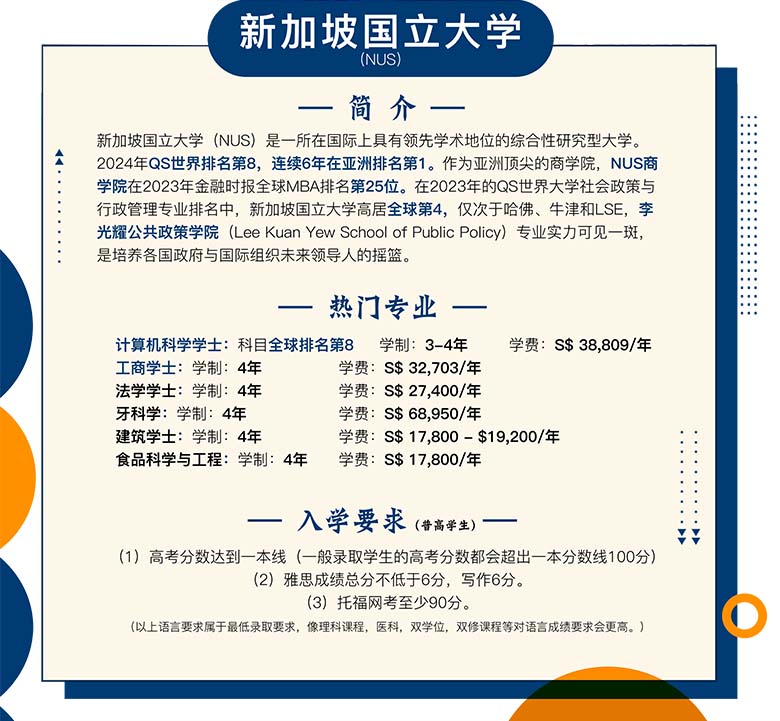National University of Singapor


The National University of Singapore (NUS) is a comprehensive research university with leading academic status internationally. In 2023, QS ranked 11th in the world and ranked 1st in Asia for five consecutive years.
The predecessor of the National University of Singapore was a Straits Settlements Medical School established in 1905. It now has three main campuses, with its main campus located in Kent Hill, a suburb of southwestern Singapore. There are also two campuses, one located at the former Bukit Chi Ma Pre Education College and the other on Orchard Road. It is a Duke University Medical Graduate School jointly established with Duke University in 2007.
1. Geographical location
The National University of Singapore campus is located in the lower part of Kent Hill, in the southwest of Singapore, 12 kilometers from the city center, and a 30 minute drive from Changi Airport in the eastern suburbs. The northern boundary of the campus is the Ayer Rajah Expressway (AYE), the southern boundary is Pasir Panjang Rd, the western boundary is Clementi Rd, and the eastern boundary is South Buona Vista Rd. The campus is roughly divided into two parts by Kent Hill, with the front part being the school district, administrative building, and recreational facilities; The rear mainly consists of research institutes and student apartments. The campus is adjacent to Singapore Science Park and National University Hospital, with convenient research conditions. To the south of the campus is the Banrang Container Port in Brazil, where you can overlook the scenery of the port area.
2. School History
The National University of Singapore was founded in 1905 and is the oldest and most prestigious university in Singapore. It is also one of the leading institutions of higher education in Asia.
The predecessor of National University can be traced back to the establishment of King Edward VII School of Medicine in 1905 and the establishment of Raffles College in 1927. These two colleges merged into the University of Malaya in 1949 and were renamed the University of Singapore in 1962. In August 1980, the University of Singapore and Nanyang University, established in 1956, officially merged to form the National University of Singapore. The university has 11 colleges offering undergraduate and graduate degree programs, 1700 doctoral students, postdoctoral experts and scholars, and 500 researchers.
3. Campus environment
KentRidge, located in the southwest of the main island of Singapore, has a campus area of 150 hectares and the layout of buildings follows the trend of the mountains. The campus is adjacent to multiple technology parks, such as Singapore Science Park I and II, Qiao Biomedical Research Park, and Qihui Information and Media Park.
4. School characteristics
The National University of Singapore, abbreviated as NUS, is one of Singapore's leading world-class universities. It is a member of the East Asian AACSB accreditation, East Asian EQUIS accreditation, the International Research University Alliance, the Universitas 21 University Alliance, and the Pacific Rim University Association, specializing in engineering, life sciences, and biomedical sciences Research in fields such as social sciences and natural sciences is renowned worldwide.
5. Departmental settings
School of Literature and Social Sciences, School of Business at National University, School of Computer Science, School of Dentistry, School of Design and Environment, School of Engineering, School of Law, Yang Luling Medical College, Yang Xiutao Music College, and School of Science.
6. Teaching characteristics
The teaching language of the National University of Singapore is English and adopts an English American style general education. She adopts a credit system and a bidding course selection system, providing guidance on course selection and matching based on students' interests.
Undergraduate application requirements:
1. General high school students
(1) The college entrance examination requires a score of around 100 points above the admission line for first tier universities
(2) The total score for IELTS is not less than 6.5, and the writing score is not less than 6.
(3) The TOEFL score should not be lower than 580 on paper and 85 on the online test.
2. Alevel candidates
(1) The minimum score for the Alevel exam is 3 A's,
(2) IELTS scores range from 6.5 to 7.0, with a recommended score of 7 in humanities.
Note: The admission conditions for each major are different, and the admission conditions for the chosen major shall prevail
Graduate application requirements:
1. Education background
Undergraduate studies at 985/211 universities (non dual tier universities can also try according to the situation)
2. Achievements
GPA greater than 80, with an advantage over 85 points
3. Professional matching
Undergraduate majors are required to be matched/related majors, and cross disciplinary difficulty is relatively high
4. Language scores
The minimum score for IELTS is 6.5 points, while the minimum score for TOEFL online test is 85 points
5. Supplement
Some majors require GRE scores, while some business majors require GMAT scores.
Note: The admission conditions for each major are different, and the admission conditions for the chosen major shall prevail
